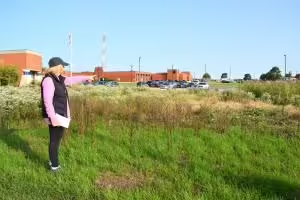PEORIA, Ill. - From the perspective of University of Illinois Extension Master Naturalists, the new prairie project at the Peoria County Juvenile Detention Center (JDC) is an excellent way to increase native plant and pollinator populations. To the JDC administrators, the project is an excellent way to save a lot of money and time mowing grass. Both reasons are making a positive impact in the community.
Extension Master Naturalist Laura Bradshaw is spearheading the project. As a seasoned volunteer in the JDC garden, Bradshaw got excited when Brian Brown, JDC Superintendent, presented her with the new prairie idea. “I started the project because Brian was interested in converting the mowed acreage of cool-season grasses into native prairie to save money on mowing and labor,” Bradshaw explained. “I saw it as an opportunity to increase diversity and the number of native plants, to encourage pollinators like butterflies and native bees, and act as habitat and food for animals such as birds and caterpillars.”
Bradshaw wrote a detailed outline that includes the establishment of an oak savanna and other prairie plots on the property including wet areas (bioswales) and the historic Peoria Farm Cemetery. The two-phase plan provides maintenance programs for 1-3 years and then 3-5 years after installation.
Bradshaw notes the work that began in 2020 included planting native swamp white oak saplings, the removal of exotic invasive plants, and the elimination of cool-season grasses in the oak savanna area in preparation for the establishment of the plot.
“In March 2021 all of the working areas were burned in preparation for prairie plantings,” Bradshaw stated. “The oak savanna was lightly tilled and overseeded with warm-season grass and forb seeds, and then native trees were planted in April.
From April through June, a prairie plot was begun (similarly to the oak savanna in preparation) in a bioswale area in front of the JDC. A team of volunteers helped plant many of the 484 plugs of native pollinator plants and grasses such as showy goldenrod, golden Alexander, whirled milkweed and purpletop grass. This summer we were happy to see the plugs become established and the oak savanna also progressing with some partridge pea, coneflower, and black eyed Susan.”
Staff from the Peoria County Soil and Water District, USDA-Natural Resource Conservation District in Edwards, IL, have been invaluable sources of advice for the project. Other Master Naturalists, Master Gardeners, and Extension staff have assisted Bradshaw with planting and weeding, guidance, and support.
The project can provide educational opportunities in conservation for the residents of the facility and the public for years to come. It has already begun to decrease the amount of mowing needed, restore the native beauty of the landscape, increase environmental sustainability by providing habitat and food for pollinators as well as for birds and mammals, and has removed an invasive species known as common reed that also threatened area farm land.
University of Illinois Extension Master Naturalists volunteer on a variety of projects throughout the state. To find out more about this program and others offered through Illinois Extension check out their website at extension.illinois.edu/fmpt.
SOURCE: Christine Belless, University of Illinois Extension, ag and natural resource program coordinator
ABOUT EXTENSION: Illinois Extension, the public outreach and engagement arm of the University of Illinois, translates research-based knowledge into actionable insights and strategies that enable Illinois businesses, families, and community leaders to solve problems, adapt to changes and opportunities, make informed decisions, and carry technical advancements forward into practice.
